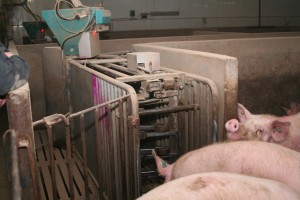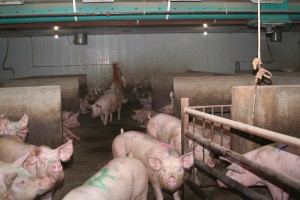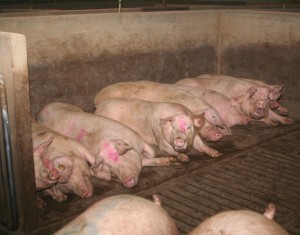A layout for group sow housing with electronic feeders that came from Holland has been working well for six years at Plain Lake Colony, Two Hills, Alberta. And, while there are a few things that he’d do differently with the benefit of experience, Hog Boss Ben Hofer says that he is very happy with the system and wouldn’t go back to sow stalls. In 2002, the Colony replaced its old 120-sow farrow to finish barn and constructed a new1200-sow unit producing isowean pigs. “We felt that sooner or later, we would be forced into using group housing, but we were also optimistic about its potential,” says Hofer, who is a Director of Alberta Pork. “We thought we could learn from the experiences in Europe and build a good system.” Having looked at both electronic feeding (ESF) and floor feeding, he felt that sow welfare was much better in the ESF system.
The decision was taken to use slatted floors rather than straw bedding, something the Dutch have a lot of experience with. All parts of the pen are slatted, apart from the lying areas. Overall pen size is 54ft x 25ft, providing a total of 24 square feet per sow and there are 6 separate lying areas divided by concrete walls, three each side of a slatted dunging area. The Nedap feeders, from Holland, are located at the front of the pen, adjacent to the access alleyway, so that they can easily be observed. “We chose the Nedap feeder because it had the fewest moving parts and the least amount of electronics on the feeder itself, which means less maintenance,” Hofer explains. “Also, some people advised us to have a feeder with a sensor on the back gate to avoid sows returning to the feeder soon after eating, but we don’t believe that’s necessary with the layout we have.” When sows leave the feeder after eating, they have to walk along a slatted alley, where the drinkers are located, and around the back of the pen, in order to return to the feeding area, which prevents constant re-visiting of the feeder by dominant sows. “This allows less dominant sows easier access to the feeder,” notes Hofer.
 Each week about 60 sows are bred in order to achieve the farrowing target of 56 per week, with sows being transferred to the group pens within 7 days of breeding. These “fixed” groups, with sows that were all bred in the same week, are much easier to manage. A boar is taken into the pen to check for returns at 18-24 days and again three weeks later. Scanning takes place at 30 days and again at around 56 days. Sows that are not pregnant are removed and returned to the breeding area.
Each week about 60 sows are bred in order to achieve the farrowing target of 56 per week, with sows being transferred to the group pens within 7 days of breeding. These “fixed” groups, with sows that were all bred in the same week, are much easier to manage. A boar is taken into the pen to check for returns at 18-24 days and again three weeks later. Scanning takes place at 30 days and again at around 56 days. Sows that are not pregnant are removed and returned to the breeding area.
Prior to breeding, gilts are housed in two large training pens adjacent to the breeding area, which each have two electronic feeders. Gilts enter the unit in groups of 40 at a weight of 110-115kg and there are 80 gilts per pen. Any gilt that does not learn to feed quickly is placed in the feeder, but there have been very few problems with training, Ben Hofer notes. “Less than 1% of gilts have failed to use the feeder,” he explains. “Of the first 600 gilts, only one needed to be culled for this reason, so it’s hardly worth mentioning.” Vasectomized boars are used for stimulation and are used to breed gilts at least once prior to natural service at second or third heat. This practice has been shown to increase first litter size. After breeding, gilts are mixed in the weekly groups with sows, a practice that Hofer says he would prefer to avoid. “If we did this again, I would have three large groups so that gilts and parity 1 sows could be housed separately from older sows,” he says.
 The benefits of individual feeding are apparent from the very even body condition of sows in the groups. Feed levels are regularly adjusted according to condition and the feeder ensures accurate feed delivery. Feed is dispensed in drops of 70 grams, every 20 seconds for sows and every 30 seconds for gilts, together with 50ml of water. The feeding cycle starts at 9.00pm, which means that, by morning, the majority of sows have fed, allowing the operator to identify any that have failed to feed. “The computer prints out an attention list and sometimes there will be 4-5 sows that have not eaten,” explains Hofer. “We don’t worry if they miss one day because most sows will eat the day after, but on day two we’ll check on the sows.” The most common reasons for feeding not taking place are lost electronic ear tags, sows that are lame and sows on heat, he says.
The benefits of individual feeding are apparent from the very even body condition of sows in the groups. Feed levels are regularly adjusted according to condition and the feeder ensures accurate feed delivery. Feed is dispensed in drops of 70 grams, every 20 seconds for sows and every 30 seconds for gilts, together with 50ml of water. The feeding cycle starts at 9.00pm, which means that, by morning, the majority of sows have fed, allowing the operator to identify any that have failed to feed. “The computer prints out an attention list and sometimes there will be 4-5 sows that have not eaten,” explains Hofer. “We don’t worry if they miss one day because most sows will eat the day after, but on day two we’ll check on the sows.” The most common reasons for feeding not taking place are lost electronic ear tags, sows that are lame and sows on heat, he says.
Experience with the system has been very positive and production runs at around 26 pigs weaned per sow, despite a roof collapse last year that put a bit of a dent in the figures. “It’s a nice environment to work in,” Hofer comments. “You can walk in and work with the sows whenever you want and they are very quiet.” He also notes that sows get more exercise than those in stalls, which means that they have better muscle condition, leading to fewer problems at farrowing. Observing and understanding sow behaviour is the key to successful management, Hofer says. “You have to handle the animals and listen to what they are telling you, not tell them what to do!” he exclaims.
 The only major aspect of the system that he would change is the type of slat. “We installed finishing slats and they are too narrow, which means we get some leg problems when sows fight after mixing,” he says. “I would prefer a slat that’s 5 to 6 inches wide, with a three-quarter inch gap to provide better support for the sow’s feet and to minimize injuries.” Another minor problem occurs when pens are part filled. “The sows tend to dung in any area that is not used for lying, which then needs cleaning out manually,” notes Hofer.
The only major aspect of the system that he would change is the type of slat. “We installed finishing slats and they are too narrow, which means we get some leg problems when sows fight after mixing,” he says. “I would prefer a slat that’s 5 to 6 inches wide, with a three-quarter inch gap to provide better support for the sow’s feet and to minimize injuries.” Another minor problem occurs when pens are part filled. “The sows tend to dung in any area that is not used for lying, which then needs cleaning out manually,” notes Hofer.
The need for maintenance and repair of electronic feeders is often cited as a problem, but experience at Plain Lake has been generally positive. “We had some initial problems with the electronic boards, but they were changed and have been working without a hitch for the last three years,” says Hofer. “The only other thing we occasionally have a problem with is the springs on the entry and exit gates, but they are easy to change.” The barn staff does the maintenance themselves, with guidance from the manufacturer by phone if required. “We’ve figured it out ourselves because most electricians and computer guys don’t understand it,” Hofer adds.
Overall, the verdict is that the system is a success and the design works well. Gilts and sows have adapted well to the feeders and production is good. Not only that but sows are calm and quiet to work with, spending most of their time asleep in the lying areas. “Learning to get used to the system was a bigger learning experience for the people than the pigs,” Hofer laughs.
Photo captions:
- Nedap feeder – The Nedap electronic feeder note the exit race that takes sows away from the feeding area once they have eaten
- Gilt pen – One of the two gilt pens showing the layout of the lying area with the slatted area in between
- Sows in lying area – Sows resting in the lying area









